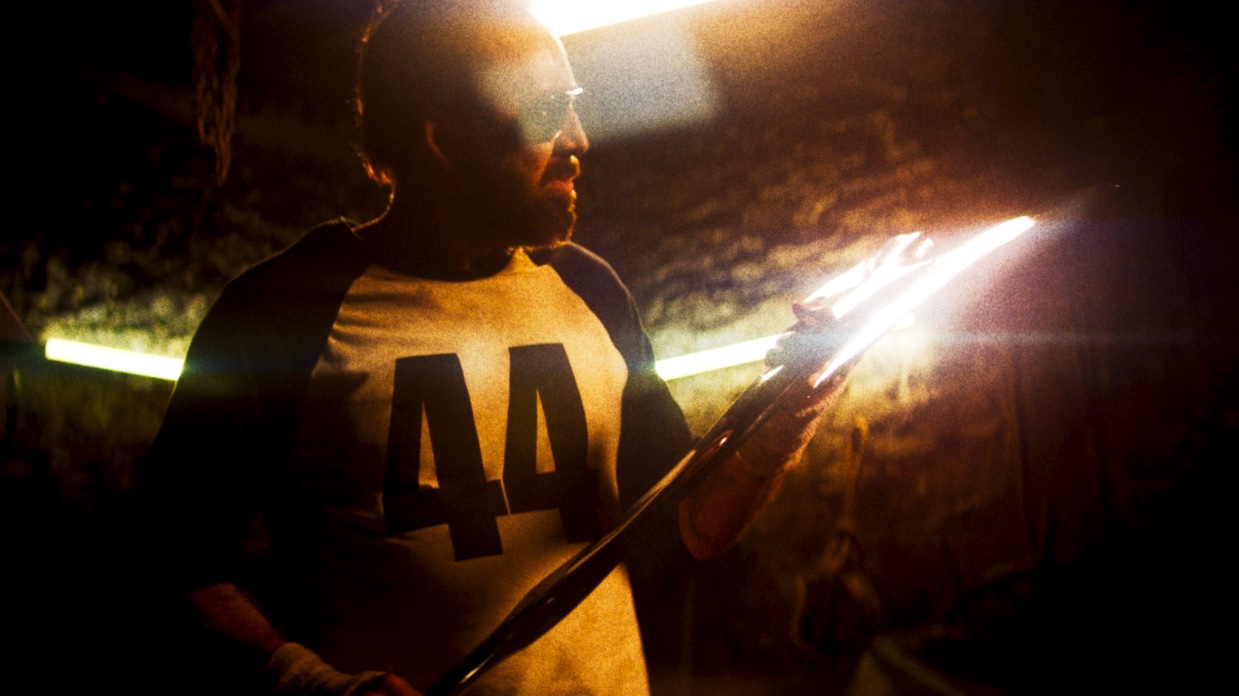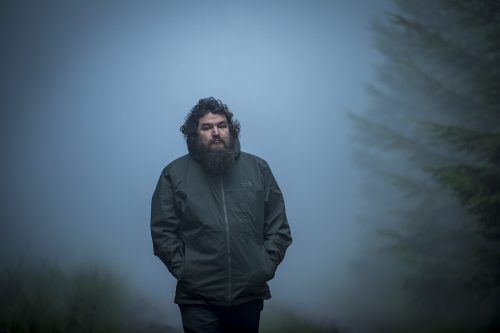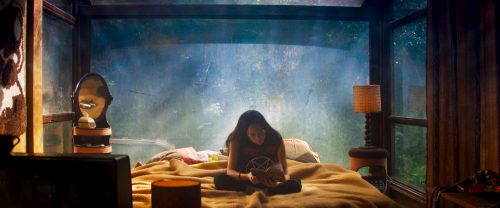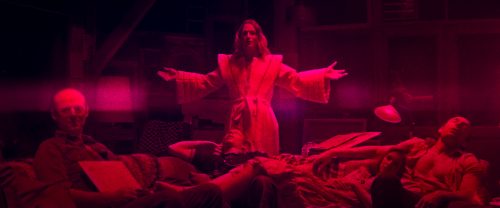 Back to selection
Back to selection
“I Wanted to Create Something Like a Heavy Metal Album Cover from the ’70s”: Panos Cosmatos on His Thrilling Nicolas Cage-Starring Revenge Drama, Mandy
 Nicolas Cage in Mandy (Photo: RLJE Films)
Nicolas Cage in Mandy (Photo: RLJE Films) Set in a dimension with certain details resembling the Pacific Northwest of the early 1980s, Mandy tells the story of a quiet, reserved lumberjack named Red Miller (Nicolas Cage), who shares a secluded cabin in the woods with the sensitive but hard-tempered Mandy Bloom (Andrea Riseborough). These two outsiders live a simple, contented life — they work, they play, they dream — until a gang of demonic bikers called the Black Skulls kidnap Mandy at the behest of deranged cult leader Jeremiah Sand (Linus Roache). Sand wishes Mandy to become the latest in his line of young brides and lovers, a mother-queen to the straggling holdouts of the Children of the New Dawn (Ned Dennehy, Olwen Fouéré, Richard Brake, among others). When Mandy rejects his offer, Sand has her burned to death in front of Red. Stripped of the one thing that gave his life meaning, Red turns to the one thing that could ease his pain: revenge.
Mandy director Panos Cosmatos (also of 2011’s science fiction psych-out Beyond the Black Rainbow) was born in Rome in 1974 to Swedish sculptor Birgitta Ljungberg and Greek film director George P. Cosmatos, who had just completed his first major feature in the Italian city state: Massacre in Rome, starring Richard Burton and Marcello Mastroianni. The young Cosmatos spent his formative years living in Sweden, the UK, Cyprus, and Mexico — where exposure to the strange, local interpretations of American pop culture had a profound and lasting effect on his creative life — before his family finally settled in British Columbia, Canada.
As a child, Cosmatos’s first exposure to cinema was through the 20-minute Super 8 highlight reels of popular films that his father would bring home to Sweden from his business trips in London. “I remember being absolutely terrified by the stop-motion dinosaurs in One Million Years B.C.,” he recalls. Later, when the family moved to London, his mother would take him to a children’s repertory cinema to see such classic — and equally traumatizing — films as Disney’s Pinnochio, 20,000 Leagues Under the Sea, and Fantasia on the big screen. “I loved movies from a very young age, and I would talk to my dad and my mom endlessly about them,” says Cosmatos. “But as a kid I actually felt kind of self-conscious about wanting to make movies of my own. Had I lived in Los Angeles I might’ve felt differently, but living on Vancouver Island — this quiet, small place — the fact that my father had a relatively abnormal job was kind of embarrassing.”
Growing up in the isolated suburbs of Vancouver Island during the ’80s, Cosmatos obsessed over the minutiae of heavy metal, fantasy art, science fiction, and horror films. “It really clicked for me in the late ’80s, when I was watching movies like Evil Dead 2 and After Hours, that a director could emotionally express themselves using the camera as a tool,” he remarks.
A brief dalliance with filmmaking included experimental university film courses, but ended with bouts of apathy and the drawn-out death of his mother in the late ’90s, after which Cosmatos descended into a nearly decade-long vortex of depression and self-destructive behavior. The passing of his father in 2005 marked a point-of-no-return for the would-be filmmaker, who resolved to pull his life together and make a movie of his own, or die trying.
“I had this real moment of clarity where I was sitting in my living room and I suddenly saw myself 10, 15 years later, still sitting in that living room and not having done, or even tried to do what I wanted to do,” says Cosmatos. “Something in my mind switched on, like a light, and I immediately moved to Vancouver to start work on Beyond the Black Rainbow.”

Filmmaker: When Beyond the Black Rainbow came out in 2011, you said you wanted it to feel like the VHS box covers of all the horror films your parents wouldn’t let you watch when you were a kid. Where does Mandy come from?
Cosmatos: I think of all my films as collectors’ items or pop culture artifacts. My guiding principle is not that “this is a story I want to tell,” it’s “this is an object,” and what are its themes and aesthetics, and how do I merge them into something like a sculpture? In the case of Mandy, it’s like an album or a song.
Filmmaker: What are some the key elements of Mandy, and how do they express themselves on the screen?
Cosmatos: I wanted to create something like a heavy metal album cover from the ’70s, with the feeling of being a kid exploring the forests and suburbs of British Columbia, reading Dungeons & Dragons modules and stuff like that, but in the way that when you’re a kid, you don’t imagine yourself as a kid. You exist in a kind of fantasy world.
Filmmaker: Why a revenge fantasy?
Cosmatos: I had a lot of unresolved anger about the way my parents died. My mother passing away was a kind of long, terrible process, and I literally thought I might just disintegrate at the moment that she died. Instead, I manifested my grief by spiraling into a binge-drinking vortex. I was kind of a shut-in, and I developed a case of extreme anxiety, to the point where I developed an aversion to horror films. I found them too visceral, and over the course of the ’90s I became more interested in foreign films and the French New Wave: Godard, Truffaut, and Rohmer, and Antonioni. Alphaville. Red Desert.
Then years later, the whole experience of my father passing away made me I realize that I hadn’t dealt with the death of my mother at all. I was completely suppressing it, and that was eating me alive, so I had to deal with it. I went into therapy, which helped me to finally find a way to express my grief properly.
I also realized that I had disconnected from the movies that meant the most to me, like Dawn of the Dead, Return of the Living Dead, American Werewolf in London, Brain Damage, Phantasm 2 and all of Cronenberg’s films, as well as the stuff I never had access to or never even knew existed when I was younger.
In particular, I found myself drawn to the revenge genre in an almost juvenile way. I watched all the Death Wish films in a sitting, including Death Wish 5, which is one of the weirdest, most leering, greasy films in that series — even after Death Wish 2, which is one of the most unpleasant nihilistic films ever made — but it was therapeutic to have these complicated feelings streamlined into a digestible, operatic sensation.
Filmmaker: But you made Black Rainbow first, which even you concede is a deliberately inaccessible film.
Cosmatos: Well, I wanted my first film to be a vivid statement, with zero compromises, about the kinds of films I wanted to make. It had to be the purest expression of my intent, something incredibly deliberate and hypnotic and slow to the point of alienating a huge portion of the audience. Mandy comes from a similar place.
Filmmaker: It took several years for the story to come together. Were you writing the whole time?
Cosmatos: Yes and no. I’m a huge procrastinator and I’ll rewrite a page over and over again. I know they say just get yourself to a draft or whatever, but I’m incapable of doing that; I have to nitpick over every word. I actually kind of hate the writing process as far as the actual mechanics of sitting there, so I thought that maybe if I worked with a co-writer I could generate some momentum and get my ideas onto the page. I had half of the script roughly filled in when I approached [co-writer] Aaron Stewart-Ahn. We were already friends, and I knew he was a good writer.
Filmmaker: What was it about Aaron’s work that made you think he would be a good collaborator?
Cosmatos: One of the things that’s most painful to write is an action sequence, because it’s an arduous, mechanical kind of thing, and I knew from Aaron’s writing sample that he wasn’t afraid of it. I thought I’d just get him to write these base-level action sequences, and then they could be tweaked or mutated to fit the tone of the film, but to my delight he was interested enough in the fetishistic specifics of genre that when we wrote together, it felt like a natural extension of my thought process. He would do a draft and then I would go over it and tweak it to my weird, micromanaging satisfaction, then give it back to him, and so on.
Filmmaker: How does the collaborative writing process compare to writing alone?
Cosmatos: Working with another writer just makes the whole process a more joyful creative experience than sitting in a room by yourself, retyping the same word 50 times.
Filmmaker: We’ve talked about conceptual development in the thematic sense, but what about the characters? How did they come to be?
Cosmatos: The characters grow around the subroutine of the film’s overarching themes, and the way they manifested on screen would in part be dictated by the qualities of the the actors who played them.
Filmmaker: Do you have actors in mind when you’re writing?
Cosmatos: I try not to, because you never know who you’re going to end up with. Like with Red Miller, I’d written him for somebody in his forties, and casting him was the biggest hurdle to getting the film made because in order to jumpstart financing we needed a name actor with enough “monetary value.” It’s some bizarre formula dictated by foreign buyers based on who they perceive to have value for the international territories, and that shifts constantly based on what movies are coming out.
Filmmaker: How did Nicolas Cage come to be involved with the film?
Cosmatos: I was infatuated with the idea of him playing the villain, Jeremiah Sand, and we offered him that role, but when we met in person, he said he wanted to play Red instead. At first, I was blindsided and disappointed because I’d been so fixated on the idea of Nic as the bad guy, but then I realized he could bring dimensions I hadn’t even dreamed of to this deceptively simple character. Now I can’t imagine anybody else playing Red.
Filmmaker: Were you at all concerned that Cage’s reputation as an actor might eclipse the character?
Cosmatos: First of all, outlandish performances don’t frighten me. I seek them out, and when it’s a combination of something outlandish and something human, to me that’s the perfect combination.
Second, I’d always perceived Nicolas Cage as an amazing artist, and I’ve been a dedicated fan of his work for most of my life, starting with Peggy Sue Got Married. His ability transcends his image, and his best performances are these bizarre kinds of interpretations. I wanted to explore — and exploit — his immense talent to its maximum potential. There’s an almost Dada-esque mentality behind it that’s hyper-aware of how to manifest himself onscreen.
Filmmaker: You described Red as a “deceptively simple character.” What are the hidden facets of his personality?
Cosmatos: One of the things I absorbed from my dad over the years was that the hero should always be an underdog. If they’re not an underdog, then you’re not going to care about them or fear for their well-being. So, Nic starts off as a seemingly normal man. In early drafts I perceived him as more of a more stoic type, but at the same time I also wanted to give him a kind of “Ash from The Evil Dead” quality, where you really feel his suffering.
But the thing about Ash is that you don’t really worry about him, and to me it was important that the audience care about Red and feel his pain, so even if he’s fighting demon bikers with a battle axe, you can still understand that he’s a sad, fucked-up guy.
Filmmaker: It feels like the protective layers around his psyche are slowly and painfully being peeled away over the course of the film.
Cosmatos: Right, and the sweaty, crying animal that he used to be is re-exposed. I tried to see him as having this kind of raw fragility, right up to the point where he takes the Black Skulls’ drug and transmogrifies into a ghoulish killing machine, a demigod, a mythical creature. The way Nic looked at it was not that he was transforming, but that he was actually becoming what he used to be before he met Mandy.

Filmmaker: Who is Mandy?
Cosmatos: She’s the center of the film’s entire life. She’s the star that Red’s world revolves around, and when the star burns out, he’s obliterated.
Filmmaker: How would you characterize her and Red’s relationship within the context of the film?
Cosmatos: Both of them are damaged people and had unpleasant lives up until the point where they met each other and were able to find some sort of solace in each other’s companionship. Whether they’re just friends or lovers I leave open to interpretation, because you can evoke feelings through a character without getting too specific about the details, and I think it’s most interesting as a viewer when you can project your own experience onto a film.
Filmmaker: Where did the character of Mandy come from?
Cosmatos: She comes from these memories of women I encountered as a kid, like the woman selling velcro wallets at the JayCee fair, this long-haired metalhead with wire glasses. I was maybe nine years old and instantly fell in love. Then later in high school, my friends and I were on LSD and went to buy weed from a woman in this strange neighborhood. Again, she was a metalhead with round, wire-rimmed glasses, and her apartment walls are covered with this insane ultra-detailed fantasy art that she’d drawn. Those two memories became the genesis of the character.
Filmmaker: How would you describe the character of Mandy?
Cosmatos: Incredibly open, but with a powerful instinct about people.
Filmmaker: That comes out very clearly in Andrea Riseborough’s performance, almost like you can see who she really is just by looking at her.
Cosmatos: Well, I wanted to kind of desexualize Mandy in such a way that the audience had to see her as a human being first, and to my delight, that was Andrea’s first instinct as well.
Filmmaker: How did Andrea’s casting embody the character of Mandy as written, and what did she bring to it?
Cosmatos: Andrea has this amazing, chameleonic ability to live in the part. Red and Mandy are outsiders, and I think she really connected with that. And she saw Mandy as a quiet, internal being. Her approach really took my breath away. I remember feeling like I was in the room with Mandy at certain points [during production], and Andrea was gone.
Filmmaker: Let’s talk about the leader of the Children of the New Dawn cult, Jeremiah Sand. And to continue the cosmic analogy, while Red and Mandy exist in this state of equilibrium, Jeremiah is like a malevolent black hole that sucks the light out of anything that comes near.
Cosmatos: There’s nothing more dangerous than a failing maniac, and I always thought of the Children of the New Dawn as a failed cult. In his imagination, Jeremiah is leading hundreds of people that worship him, but in reality he’s barely able to accumulate a half-dozen people for this shitty, transient existence, and his imagination is so lacking that he literally takes these people into a hole in the ground by the end of the movie.

Filmmaker: You said you originally wanted to cast Cage in this role. How did you come to cast Linus Roache?
Cosmatos: Jeremiah was a difficult role to cast because if we had been able to cast an American, there are literally a thousand people I could’ve chosen from, but we were obligated by our production contract to hire a European actor, and European men are almost a different breed of human being all together.
Filmmaker: What do you mean?
Cosmatos: A lot of American leading male-types have this tanned and handsome and confident image; all the guys I grew up watching play heroes on TV fit the visual and tonal template for a cult leader or a perverted figure of power. Initially, I found myself looking at only leading men, not character actors.
Filmmaker: But like all good character actors, Roache doesn’t fit a template, he transforms himself and completely disappears into the part.
Cosmatos: And he was able to bring a unique insight to the character because it turns out that he had actually recently extricated himself from a cult experience after the leader had a full-on meltdown that shattered his followers’ illusions of him. I thought that was pretty interesting and very similar to what happens to Sand when Mandy strips away his force field of authority.
Filmmaker: Religion and fanaticism are recurrent themes in your work. What is your fascination with these themes?
Cosmatos: In Beyond the Black Rainbow I wanted to explore the baby boomer New Age religion fixation, like the way people expose themselves to mind viruses and let these things control their lives. With Mandy I wanted to continue that exploration specific to how most, if not all, modern religions are reinterpretations — or perversions — of their original intentions.
Filmmaker: Did you come from a religious family?
Cosmatos: I think my father considered himself a Christian, but it always felt like a learned behavior, not something that he truly, deeply believed in. My mother had an open relationship with the idea of spirituality, but she was skeptical of structure. I remember when we first moved to Canada, she took me to this one church — I was probably seven years old at the time — and afterwards she asked me what I thought about it. I said it seemed fake. She agreed that it didn’t seem to have much to do with spirituality at all. We never tried to find another church and I never went on my own.
Filmmaker: Are you a spiritual person?
Cosmatos: I’m a hardcore atheist who believes that our existence is completely pointless and futile. I think you can find personal meaning in your life, and at the risk of sounding corny, I think loving people and being loved is important to being a healthy human being.
Filmmaker: That’s not corny. Optimistic, maybe.
Cosmatos: I just don’t abide by the idea that people need religion in order to live moral, honorable lives. I think it’s built into us on a DNA-base level to respect and help each other and live good lives. That’s the ideal, but at the end of the day we’re just a bunch of ants on a rock in the middle of a void, so in the grand scheme of things nothing we do really matters, but there’s still something to be said for trying to make the world a better place. Do you really want to spend your entire existence being a nasty, toxic creature that destroys everything? It seems exhausting.
Filmmaker: But we do have those kinds of people in the world. Those people exist in your films.
Cosmatos: I don’t know, some people are just sociopaths no matter what belief system you give them.
Filmmaker: At what point during the making of Mandy did you start thinking about music?
Cosmatos: From the very beginning, just like with Black Rainbow. A lot of my best writing gets done when I’m listening to music, and when I say “writing” I don’t mean I’m sitting at the typewriter with music blasting. For me, writing can be just lying there and imagining, or driving and imagining. So just like starting with a poster and a tagline and a title, I’ll make an unofficial soundtrack that builds and changes over time.
Filmmaker: What were some of your musical touchstones?
Cosmatos: I actually don’t like to talk about specifically who I listen to, because it feels like a private thing, but one of the ones I will mention is Queen’s Flash Gordon soundtrack. That played into my early conversations with Jóhann Jóhannsson. I wanted the film to be a visual sonic experience, like a disintegrating rock opera.
Filmmaker: I spoke with soundtrack supervisor Randall Dunne and he mentioned that Jóhann saw the film before starting work on the score. How far along in the editing process were you at that point?
Cosmatos: It was a rough cut.
Filmmaker: Was the editorial process affected by Jóhann’s music?
Cosmatos: Generally I don’t edit to the soundtrack, I want the composer to build their sound around what’s on the screen.
Filmmaker: How would you characterize your collaboration with Jóhann?
Cosmatos: Some of our collaboration was extremely specific, and I’d dictate the emotional notes for certain moments, but generally I gave him a broad interpretive direction. At one point I told Jóhann I wanted a scene to feel like being in the backseat of your big brother’s Trans Am and you can smell the yellow air freshener tree and the leather of the seats. He’s smoking weed and you’re kind of terrified, but at the same time it’s a thrilling experience. He knew exactly what I was talking about.
Filmmaker: Your work on the film was complete and Jóhann’s work was complete by the time he died, correct?
Cosmatos: Yeah, and some of the sound files were unmixed, as many as eight or 16 tracks. We were working with stems so we could tweak it a little bit in the edit and mix, sift through them and hone the music out.
Filmmaker: How do you process your feelings about death, aside from your work as a filmmaker?
Cosmatos: Apart from my parents, I’ve lost a few friends over the years to drug overdoses and things like that. The hardest part is just missing them when you need them, or when you want to talk to them. It’s the same thing with your close friends. When Jóhann died, it felt like I lost a brother. I thought this was the beginning of a long, creative relationship, you know? And then he was gone. You just have to learn to live with the absence of that person.
Filmmaker: A lot of revenge films seem to come from from a moral or ethical position, like the avenger has to avenge because the person who wronged them deserves it, or it’s justice, or they’re seeking an ultimately misguided catharsis.
Cosmatos: I actually think [the act of vengeance] really does help the characters. I wouldn’t want to make a movie that punished the person taking revenge, and I tend to prefer films that don’t moralize about it.
